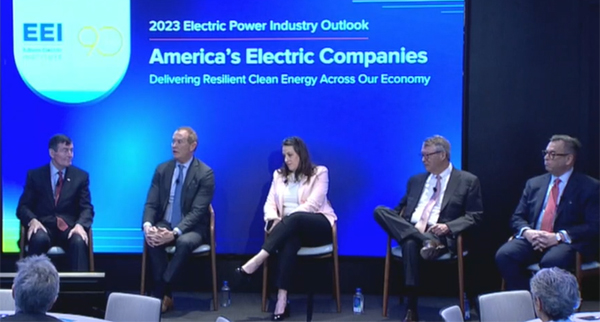Public Service Enterprise Group CEO Ralph Larossa said Tuesday that the utility is “not going to be” in the offshore wind business but sees potential in keeping its three nuclear plants alive now that they are eligible for federal tax credits under the Inflation Reduction Act (IRA).
Larossa made his comments during the company’s year-end earnings call, the first since the utility announced it would sell its 25% stake in Ocean Wind 1, New Jersey’s first offshore wind project, which will be fully owned by Danish developer Ørsted. Larossa said the sale, which is expected to close in the first half of the year, would bring in about $200 million, the same that the company paid for it.
“Just unequivocally, we’re not going to be in the offshore generation business,” Larossa said in response to a question from an investment analyst. “We’ll just be keeping an eye on the market and see what makes sense.”
The utility also has decided not to pursue an ownership interest in Ørsted’s second New Jersey project, Ocean Wind 2, and won’t exercise its option to purchase 50% of Ørsted’s two Skipjack generating projects in Maryland, the utility said in a release. The utility also is mulling whether or notto sell its 50% interest in Garden State Offshore Energy, which holds rights to an offshore wind lease area south of New Jersey.
“This decision to exit offshore generation was consistent with our goal to increase the predictability of our business,” Larossa said. However, the utility will provide onshore construction management and substation and cabling work for the project and will “continue pursuing regulated transmission projects offshore,” he said.
PSEG last year partnered with Ørsted to submit several proposals for a New Jersey Board of Public Utilities solicitation seeking ways to upgrade the state’s transmission system to handle offshore wind, but none were picked. (See PSEG Sees Potential $3B OSW Transmission Spending.)
Game Changer
Larossa said he considered the passage of the IRA a “game changer” that should provide the “stability required for long-term financial viability” for the nation’s nuclear generators. The utility owns the Hope Creek nuclear station and co-owns the Salem reactors with Exelon.
The BPU in 2019 and 2021 awarded PSEG a total $600 million a year for three years under the state’s Zero Emissions Certificate (ZEC) program, which provides subsidies to nuclear plants that demonstrate they are at risk of closure. (See NJ Nukes Awarded $300 Million in ZECs.)
The IRA awards a tax credit of 0.3 cents/kWh of power produced to qualified nuclear power generators, a subsidy that can be five times larger if the facility pays prevailing wages.
“As a result of the nuclear production tax credits extending through at least 2032, we are now able to consider small but important value added investments,” Larossa said. These include “the potential for capacity upgrades to Salem, a fuel cycle extension to Hope Creek and the license extension of our New Jersey units.”
“Critical to these decisions will be our determination of how predictable and visible nuclear revenues could be beyond our current three-year ZEC window,” he said.
In addition, he said the utility sees potential from IRA subsidies that could prompt consumers to transition to electric vehicles, which will “expand our opportunities to invest in last-mile reliability and make-ready infrastructure,” he said.
Larossa also said PSEG’s focus on clean energy, with the company last year completing the sale of the last of its fossil-fueled generating plants, aligns with that of New Jersey Gov. Phil Murphy and the state legislature.
Murphy last week announced an acceleration of the state’s clean energy goals, moving the target date by which the state should reach 100% clean electricity from 2050 to 2035. He also said the state would soon begin the process of adopting a version of California’s Advanced Clean Cars II rules, which would ban the sale of new gasoline-powered cars by 2035. (See NJ Governor Sets Out Accelerated Emissions Targets.)
Murphy also signed an executive order that would require the installation of electric heating and cooling equipment in 400,000 homes and 20,000 commercial properties by 2030, a sign of his determination to move the state away from gas-fired heating and hot water units.
“There’s a lot of good news in that announcement last week for a company like ours,” Larossa said, noting that the utility has placed a high priority on upgrading the “last mile” connections with customers that will become even more crucial with the increase of EV chargers.
“I think this just kind of reinforces the need for it from a customer standpoint or from a reliability standpoint,” he said.
Larossa added that the company’s gas business has not suffered fallout from Russia’s invasion of Ukraine. “We are not as dependent on Russian fuel supply at all for our fuel supply,” he said.
He also said he was not worried about the impact of New Jersey shifting away from gas and electrifying.
“It’s a mixed bag for us,” he said. “We have some gas-only territory, some electric-only territory. But the bulk of our customers are combined. So you know, I don’t want to say it’s a win-win. But it is a win-win for us to a great extent.”
Q4 Results
PSEG’s full-year and fourth-quarter results improved on 2021.
The company reported 2022 net income of $1,031 million ($2.06/share), compared with $648 million ($1.29/share) for 2021. Net income for the fourth quarter was $788 million ($1.58/share), compared to $445 million ($0.88/share) a year earlier.


